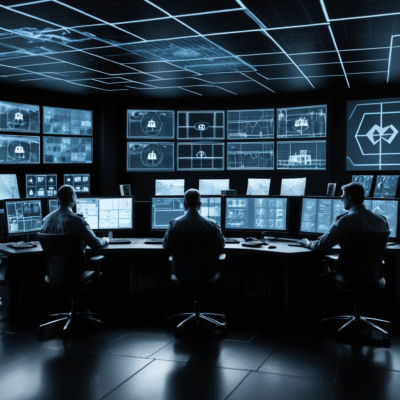The Cybersecurity Threats to America’s Power Grid Are Real

In today’s increasingly digital world, the U.S. power grid… an intricate web of infrastructure that fuels the nation’s homes, businesses, and essential services, is at greater risk than ever. Cybersecurity threats, especially those posed by sophisticated hackers from nation-states, present a clear and immediate danger to America’s critical infrastructure.
The threat of a debilitating cyberattack grows as the grid becomes more interconnected and more reliant on sophisticated technology. Recent incidents and evolving new, enhanced tactics highlight vulnerabilities in grid technology and underscore the need for strengthened security measures.
How Cyber Threats Target the U.S. Power Grid
The U.S. power grid consists of thousands of generation plants, transmission lines, and substations, all working together to supply electricity to millions of households. However, as the grid has modernized, adding digital control systems and remote capabilities, it has also become more vulnerable to cyberattacks. The Supervisory Control and Data Acquisition (SCADA) systems and Industrial Control Systems (ICS) that manage and monitor grid operations are especially susceptible to attack.
These systems, once isolated, are now often connected to the internet, making them potential entry points for hackers. Nation-states, including Russia, China, Iran, and North Korea, have all been identified as sources of potential cyber threats to the U.S. grid. These adversaries may target the grid for several reasons: to disrupt the economy, undermine national security, or prepare for future conflicts by exploring weaknesses in critical infrastructure. Unfortunately, the aforementioned nation-states will likely use proxies, making it difficult, if not impossible, to determine the true source of the attack.
Recent Cyberattacks On Critical Grid Infrastructure
While the U.S. power grid has yet to experience a full-scale blackout caused by a cyberattack, recent incidents provide a glimpse into the potential devastation of a successful hack. In 2015 and 2016, Russian hackers successfully targeted Ukraine’s power grid, causing widespread blackouts and leaving hundreds of thousands without power. These incidents were among the first confirmed cases of hackers using malware to take down an entire power grid. The attacks on Ukraine served as a wake-up call for other nations, including the U.S., as they demonstrated the real-world impact of cyber threats on energy infrastructure.
In the U.S., the 2021 ransomware attack on Colonial Pipeline highlighted the vulnerability of the country’s energy infrastructure to cyber threats. Although this attack did not target the power grid specifically, it led to fuel shortages and price spikes across the East Coast, showing how a cyberattack on critical infrastructure can cause widespread disruption. Additionally, in 2019, the U.S. Department of Homeland Security (DHS) warned that Russian hackers had infiltrated the control rooms of U.S. power plants, gaining access to sensitive systems. While no major outages occurred, this breach emphasized that foreign adversaries are actively probing and testing the defenses of the U.S. grid.
Critical Vulnerabilities In Grid Technology
The power grid’s digital transformation has introduced numerous vulnerabilities while improving efficiency and reliability. Older infrastructure and outdated software in SCADA and ICS systems can be challenging to secure, as many were not designed with cybersecurity in mind. These systems often lack basic protections, such as encryption and multi-factor authentication, making them susceptible to attacks. The widespread use of third-party vendors for maintenance and software updates also adds to the risk. If a vendor’s system is compromised, it could provide an entry point for hackers into the larger grid network.
Another issue is the grid’s decentralized nature. The U.S. power grid is divided into three major interconnections: the Eastern Interconnection, the Western Interconnection, and the Texas Interconnection. Each interconnection comprises multiple independent utilities and operators, challenging coordination on cybersecurity standards. Additionally, state regulators and private utilities may lack the resources or incentives to implement robust cybersecurity practices, leaving certain grid regions more vulnerable than others.

Inside a power grid control room, operators monitor systems closely, attempting to protect critical infrastructure.
Efforts To Strengthen Cybersecurity In The Power Sector
Recognizing these vulnerabilities, the federal government and industry stakeholders have ramped up efforts to protect the grid from cyber threats. The Department of Energy (DOE), Cybersecurity and Infrastructure Security Agency (CISA), and Federal Energy Regulatory Commission (FERC) have all introduced measures aimed at bolstering grid security.
In 2018, the DOE launched the Cybersecurity for Energy Delivery Systems (CEDS) program to develop innovative technologies and tools to protect the grid. Through this program, the DOE collaborates with private companies, universities, and national laboratories to create new cybersecurity solutions tailored to the unique needs of the energy sector.
Additionally, the DOE’s Office of Cybersecurity, Energy Security, and Emergency Response (CESER) focuses on protecting energy infrastructure from cyber threats and responding to incidents when they occur.
The North American Electric Reliability Corporation (NERC) has also implemented critical infrastructure protection (CIP) standards, which establish baseline cybersecurity requirements for grid operators. These standards require utilities to assess and mitigate risks regularly, secure sensitive information, and monitor for potential threats. However, compliance with NERC standards remains a work in progress, as not all utilities have adopted these practices uniformly.
Emerging Technologies And The Path Forward
To stay ahead of cyber adversaries, the U.S. power sector is increasingly exploring advanced technologies such as artificial intelligence (AI) and machine learning (ML) to enhance threat detection and response. AI-driven systems can analyze vast amounts of data from grid sensors and quickly identify anomalies that may indicate an impending cyberattack. By automating threat detection and response, these technologies offer a proactive approach to cybersecurity, reducing the response time required to mitigate threats.
However, technology alone is not enough. Continued investment in workforce training, public-private collaboration, and information sharing will be essential to safeguarding the grid. The government has implemented some programs to train cybersecurity professionals. Still, there remains a shortage of skilled workers who understand both IT security and the operational technology used in the power sector.
Preparing The Grid For Future Attacks
The cybersecurity threat to America’s power grid is a pressing concern, and recent attacks serve as a stark reminder of the risks posed by foreign adversaries and cybercriminals. As the grid modernizes and adopts new technologies, its vulnerabilities will continue to evolve. The U.S. must remain vigilant, implementing robust cybersecurity measures, investing in workforce training, and fostering collaboration between the public and private sectors.
For the average American, a cyberattack on the power grid could mean prolonged blackouts, disrupted services, and widespread economic impacts. Protecting the grid is not just a matter of national security; it is essential to maintaining the quality of life for millions of people. By prioritizing cybersecurity, the U.S. can work to ensure that its power grid remains resilient in the face of growing digital threats.
The post The Cybersecurity Threats to America’s Power Grid Are Real appeared first on Off The Grid News.
Source: https://www.offthegridnews.com/grid-threats/the-cybersecurity-threats-to-americas-power-grid-are-real/
Anyone can join.
Anyone can contribute.
Anyone can become informed about their world.
"United We Stand" Click Here To Create Your Personal Citizen Journalist Account Today, Be Sure To Invite Your Friends.
Before It’s News® is a community of individuals who report on what’s going on around them, from all around the world. Anyone can join. Anyone can contribute. Anyone can become informed about their world. "United We Stand" Click Here To Create Your Personal Citizen Journalist Account Today, Be Sure To Invite Your Friends.
LION'S MANE PRODUCT
Try Our Lion’s Mane WHOLE MIND Nootropic Blend 60 Capsules
Mushrooms are having a moment. One fabulous fungus in particular, lion’s mane, may help improve memory, depression and anxiety symptoms. They are also an excellent source of nutrients that show promise as a therapy for dementia, and other neurodegenerative diseases. If you’re living with anxiety or depression, you may be curious about all the therapy options out there — including the natural ones.Our Lion’s Mane WHOLE MIND Nootropic Blend has been formulated to utilize the potency of Lion’s mane but also include the benefits of four other Highly Beneficial Mushrooms. Synergistically, they work together to Build your health through improving cognitive function and immunity regardless of your age. Our Nootropic not only improves your Cognitive Function and Activates your Immune System, but it benefits growth of Essential Gut Flora, further enhancing your Vitality.
Our Formula includes: Lion’s Mane Mushrooms which Increase Brain Power through nerve growth, lessen anxiety, reduce depression, and improve concentration. Its an excellent adaptogen, promotes sleep and improves immunity. Shiitake Mushrooms which Fight cancer cells and infectious disease, boost the immune system, promotes brain function, and serves as a source of B vitamins. Maitake Mushrooms which regulate blood sugar levels of diabetics, reduce hypertension and boosts the immune system. Reishi Mushrooms which Fight inflammation, liver disease, fatigue, tumor growth and cancer. They Improve skin disorders and soothes digestive problems, stomach ulcers and leaky gut syndrome. Chaga Mushrooms which have anti-aging effects, boost immune function, improve stamina and athletic performance, even act as a natural aphrodisiac, fighting diabetes and improving liver function. Try Our Lion’s Mane WHOLE MIND Nootropic Blend 60 Capsules Today. Be 100% Satisfied or Receive a Full Money Back Guarantee. Order Yours Today by Following This Link.






